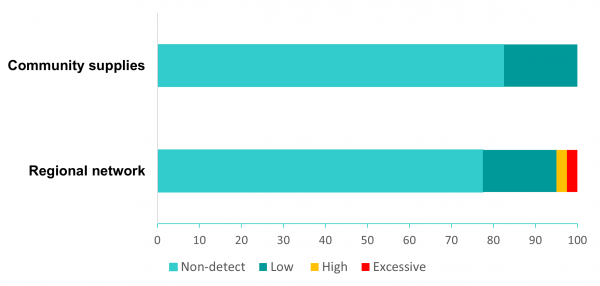Pesticides in groundwater report card
Why we monitor pesticides in groundwater
Waikato Regional Council is responsible for groundwater resource management in the Waikato region. People use groundwater for drinking, domestic and industrial purposes, stockwatering and crop irrigation. Poor pesticide management and use may contaminate groundwater supplies, harming people, animals and plants.
This indicator measures the occurrence of pesticides in the Waikato region’s groundwater supplies. Information is derived from two data sets - community water supplies and a regional monitoring network of wells. The information tells us about the quality of our groundwater, and whether it meets drinking water standards for pesticides.
What's happening?
Large quantities of pesticides are used in the Waikato region. Between 1985 and 1987, 335 tonnes of herbicide, 84 tonnes of insecticide and 155 tonnes of fungicide were used annually.
Most pesticides break down at the surface or in shallow soil, but some mobile and persistent chemicals reach groundwater. Health and environmental concerns have increased awareness of the need for careful pesticide management and led to a decrease in use nationally since 1994. Also much less persistent chemicals are now being used that more readily degrade to environmentally harmful compounds.
A national survey of pesticide contamination of New Zealand aquifers undertaken in 2002 found pesticides in 21 percent of groundwater samples collected at the 133 well sites.
In 1995, Waikato Regional Council investigated pesticide occurrence in groundwater at well sites where these chemicals were in regular use and the aquifers were considered vulnerable. Pesticides were detected in groundwater at 74 percent of a 'worst case' selection of 35 wells. Of the 20 different compounds detected, only dieldrin from sheep dip sites exceeded the drinking water guideline.
Methods - how we monitor
Results - data and trends
Download the data file
This Excel spreadsheet contains the source data to this indicator's graph and any additional data. The file is in excel format.
Resources
Aller, L., Bennett,T., Lehr, J.H., Petty, R.J. & Hackett, G. 1987: DRASTIC: A standardised system for evaluation of ground water pollution potential using hydrogeologic settings. Environmental Protection Agency, Washington DC 130 p.
Environment Waikato. 1998: Waikato State of Environment Report 1998. Environment Waikato, Hamilton.
Hadfield, J.C. and Smith, D., 1999: Pesticide contamination of groundwater in the Waikato Region. Environment Waikato Technical Report 1999/9, Environment Waikato, Hamilton
Holland, P. and Rahman, A. 1999: Review of trends in agricultural pesticide use in New Zealand. MAF Policy Technical Paper 99/11, 53 p.
Rosen, M. R., S. G. Cameron, C. B. Taylor and R. R. Reeves. 1999: New Zealand Guidelines for the Collection of Ground Water Samples for Chemical and Isotopic Analyses. The Institute of Geological and Nuclear Sciences. Lower Hutt. 1999/9.
When this indicator is updated
The pesticide indicator will be updated every four years, after each round of sampling.
Updated July 2021.






To ask for help or report a problem, contact us
Tell us how we can improve the information on this page. (optional)